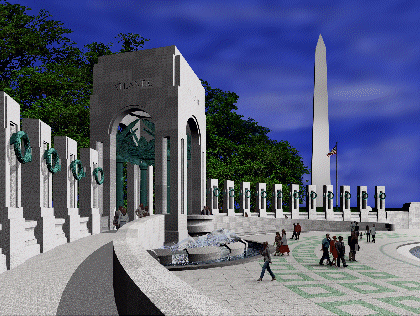As for the World War II memorial, it at least as frightening as the barricades, for its pseudo-classical design, which looks like a collaboration between Albert Speer and Benito Mussolini, represents the two primary forms of our nation's response
 to the terror threat: militarism and totalitarianism. Our contemporary militarism is palpable: all of Bush's substantive responses to 9/11 have been military (even the diplomatic activity has focused on military cooperation), and the military's profile in our culture is growing precipitously. Note, for instance, the airtime lavished on GIs stationed overseas during the Thanksgiving Day football coverage. Or consider the many uncritical and propagandistic pieces glorifying the prowess and virtue of our military, both on major television networks and even in respectable news outlets such as the Washington Post and the New York Times, both of which have run hagiographic profiles of Special Forces soldiers and post-9/11 recruits that might as well have been written by the Pentagon's media relations people. Whatever one makes
of the present war on Iraq, these images are elaborating a veritable cult of the Special Forces. Like the anti-drug messages snuck into sitcoms by a government agency, watch for more and more movies and television programming about Marines, Green Berets, S.E.A.L.s, etc.
to the terror threat: militarism and totalitarianism. Our contemporary militarism is palpable: all of Bush's substantive responses to 9/11 have been military (even the diplomatic activity has focused on military cooperation), and the military's profile in our culture is growing precipitously. Note, for instance, the airtime lavished on GIs stationed overseas during the Thanksgiving Day football coverage. Or consider the many uncritical and propagandistic pieces glorifying the prowess and virtue of our military, both on major television networks and even in respectable news outlets such as the Washington Post and the New York Times, both of which have run hagiographic profiles of Special Forces soldiers and post-9/11 recruits that might as well have been written by the Pentagon's media relations people. Whatever one makes
of the present war on Iraq, these images are elaborating a veritable cult of the Special Forces. Like the anti-drug messages snuck into sitcoms by a government agency, watch for more and more movies and television programming about Marines, Green Berets, S.E.A.L.s, etc.
The totalitarianism is less palpable but far more dangerous. The militaristic consensus in the media shows little tolerance for inquiry and critical thinking, a task subsequently left to cranks like Chomsky. The other is that quiet war being waged on our civil liberties by John Ashcroft and, more recently, John Poindexter. The Bush administration is intent on spying on us while keeping more and more of its own activities secret. What is Cheney hiding? And Kissinger?
Viewing what has been going on around us as installation art helps us 'read' what we see and understand its meaning. Yet Hirst has art's political function wrong. He wants reality - 9/11, truck bombs, Orwellian government agencies - to help us see art. But effective political art does the opposite: it uses the language of art to help us see the real violence and anxiety to which we are ordinarily blind. Perhaps for that reason it would be best if the Park Service left the Jersey barriers right where they are.

Arte Povera, Damien Hirst, and Pomo Intellectuals
December, 2002
Pierre Bonnard at the Phillips Collection
November, 2002
Why modern art survives in a postmodern age
October, 2002
The Art of the Press Conference
September, 2002
Totalitarianism, kitsch, and Mamma Mia
August, 2002
What is modernism?
July, 2002
What's the difference between laughing with art and laughing at it?
June, 2002
At college drawing classes, looking for the real art among the posing.
May, 2002
What draws protesters to shout about banal holocaust art?
April, 2002



film politics music jay's head poetry art josh ring fysche saddies about archive